The Threat of Moisture in the Partitions of Unheated and Heated Wooden Historic Churches in Poland
Abstract
1. Introduction
2. Materials and Methods
2.1. Research Objects
2.2. Measuring Apparatus
2.3. Numerical Analysis

3. Results and Analysis
3.1. Comparison of Development of Temperature and Relative Air Humidity in Studied Objects
3.2. Numerical Analysis of the Risk of Water Vapor Condensation
4. Discussion
5. Summary and Conclusions
Author Contributions
Funding
Institutional Review Board Statement
Informed Consent Statement
Data Availability Statement
Conflicts of Interest
References
- Martínez-Molina, A.; Tort-Ausina, I.; Cho, S.; Vivancos, J.-L. Energy efficiency and thermal comfort in historic buildings: A review. Renew. Sustain. Energy Rev. 2016, 61, 70–85. [Google Scholar] [CrossRef]
- Akkurt, G.G.; Aste, N.; Borderon, J.; Buda, A.; Calzolari, M.; Chung, D.; Costanzo, V.; Del Pero, C.; Evola, G.; Huerto-Cardenas, H.E.; et al. Dynamic thermal and hygrometric simulation of historical buildings: Critical factors and possible solutions. Renew. Sustain. Energy Rev. 2020, 118, 109509. [Google Scholar] [CrossRef]
- Verticchio, E.; Martinelli, L.; Gigliarelli, E.; Calcerano, F. Current practices and open issues on the whole-building dynamic simulation of historical buildings: A review of the literature case studies. Build. Environ. 2024, 258, 111621. [Google Scholar] [CrossRef]
- Lisitano, I.M.; Laggiard, D.; Fantucci, S.; Serra, V.; Fenoglio, E. Evaluating the Impact of Indoor Insulation on Historic Buildings: A Multilevel Approach Involving Heat and Moisture Simulations. Appl. Sci. 2021, 11, 7944. [Google Scholar] [CrossRef]
- Semko, O.; Yurin, O.; Filonenko, O.; Semko, V.; Rabenseifer, R.; Mahas, N. Investigation of Moisture Condensation on the Surface of the Bottom Chord of a Steel Truss of a Historical Building. Buildings 2023, 13, 766. [Google Scholar] [CrossRef]
- Sokołowski, P.; Nawalany, G.; Michalik, M. Analysis of the Impact of Flooring Material and Construction Solutions on Heat Exchange with the Ground in a Historic Wooden Building. Energies 2022, 15, 5924. [Google Scholar] [CrossRef]
- Andreotti, M.; Bottino-Leone, D.; Calzolari, M.; Davoli, P.; Dias Pereira, L.; Lucchi, E.; Troi, A. Applied Research of the Hygrothermal Behaviour of an Internally Insulated Historic Wall without Vapour Barrier: In Situ Measurements and Dynamic Simulations. Energies 2020, 13, 3362. [Google Scholar] [CrossRef]
- Ferdyn-Grygierek, J.; Baranowski, A. Internal environment in the museum building—Assessment and improvement of air exchange and its impact on energy demand for heating. Energy Build. 2015, 92, 45–54. [Google Scholar] [CrossRef]
- Nawalany, G.; Sokołowski, P.; Michalik, M. Analysis of the Operation of an Unheated Wooden Church to the Shaping of Thermal and Humidity Conditions Using the Numerical Method. Energies 2021, 14, 5200. [Google Scholar] [CrossRef]
- Sadłowska-Sałęga, A.; Radoń, J. Feasibility and limitation of calculative determination of hygrothermal conditions in historical buildings: Case study of st. Martin church in Wiśniowa. Build. Environ. 2020, 186, 107361. [Google Scholar] [CrossRef]
- Xiong, J.; Li, A.; Liu, C.; Dong, J.; Yang, B.; Cao, J.; Ren, T. Probing the historic thermal and humid environment in a 2000-year-old ancient underground tomb and enlightenment for cultural heritage protection and preventive conservation. Energy Build. 2021, 251, 111388. [Google Scholar] [CrossRef]
- Harrestrup, M.; Svendsen, S. Full-scale test of an old heritage multi-storey building undergoing energy retrofitting with focus on internal insulation and moisture. Build. Environ. 2015, 85, 123–133. [Google Scholar] [CrossRef]
- Kon, O.; Caner, İ. The Effect of External Wall Insulation on Mold and Moisture on the Buildings. Buildings 2022, 12, 521. [Google Scholar] [CrossRef]
- Mleczkowska, A.; Strojecki, M.; Bratasz, Ł.; Kozłowski, R. Particle penetration and deposition inside historical churches. Build. Environ. 2016, 95, 291–298. [Google Scholar] [CrossRef]
- Ferdyn-Grygierek, J.; Kaczmarczyk, J.; Blaszczok, M.; Lubina, P.; Koper, P.; Bulińska, A. Hygrothermal Risk in Museum Buildings Located in Moderate Climate. Energies 2020, 13, 344. [Google Scholar] [CrossRef]
- Kalamees, T.; Väli, A.; Kurik, L.; Napp, M.; Arümagi, E.; Kallavus, U. The Influence of Indoor Climate Controlon Risk for Damage sin Naturally Ventilated Historic Churches in Cold Climate. Int. J. Archit. Herit. 2015, 10, 486–498. [Google Scholar] [CrossRef]
- Web, A.L. Energy retrofits in historic and traditional buildings: A review of problems and methods. Renew. Sustain. Energy Rev. 2017, 77, 748–759. [Google Scholar] [CrossRef]
- Nawalany, G.; Sokołowski, P.; Michalik, M. Experimental Study of Thermal and Humidity Conditions in a Historic Wooden Building in Southern Poland. Buildings 2020, 10, 118. [Google Scholar] [CrossRef]
- Maroy, K.; Steeman, M.; De Backer, L.; Janssens, A.; De Paepe, M. Conservation Climate Analysis of a Church Containing Valuable Artworks. Energy Procedia 2015, 78, 1269–1274. [Google Scholar] [CrossRef]
- Bratasz, Ł. Allowable microclimatic variations for painted wood. Stud. Conserv. 2013, 58, 65–79. [Google Scholar] [CrossRef]
- Nawalany, G.; Sokołowski, P. Building–Soil Thermal Interaction: A Case Study. Energies 2019, 12, 2922. [Google Scholar] [CrossRef]
- Sokołowski, P.; Nawalany, G. Analysis of Energy Exchange with the Ground in a Two-Chamber Vegetable Cold Store, Assuming Different Lengths of Technological Break, with the Use of a Numerical Calculation Method—A Case Study. Energies 2020, 13, 4970. [Google Scholar] [CrossRef]
- PN EN 15757; Conservation of Cultural Property—Specifications for Temperature and Relative Humidity to Limit Climate-Induced Mechanical Damage in Organic Hygroscopic Materials. iTeh, Inc.: Newark, DE, USA, 2010.
- Żaba, A.; Marchacz, M. Historical climate of the historic church of St. George at Ostropa. E3S Web Conf. 2018, 49, 00138. [Google Scholar] [CrossRef]
- Cichowicz, R.; Jerominko, T.; Grzelakowski, T.; Zaguła, A. Contemporary Challenges for Heating Historic Church Buildings from the Late 19th and Early 20th Centuries. Energies 2025, 18, 889. [Google Scholar] [CrossRef]
- ASHREA. Guideline 14–2014: Measurement of Energy and Demand Savings; ASHRAE: Atlanta, GA, USA, 2014. [Google Scholar]
- Webster, L.; Bradford, J.; Sartor, D.; Shonder, J.; Atkin, E.; Dunnivant, S.; Frank, D.; Franconi, E.; Jump, D.; Schiller, S.; et al. M&v Guidelines: Measurement and Verification for Performance-Based Contracts; Technical Report, Version 4.0; Nexant, Inc.: Boulder, CO, USA, 2015. [Google Scholar]
- Abergel, T.; Dulac, J.; Hamilton, I.; Jordan, M.; Pradeep, A. Global Status Report for Buildings and Construction-Towards a Zero-Emissions, Efficient Resilient Build and Construction Sector; United Nations Environment Programme: Nairobi, Kenya, 2019. [Google Scholar]
- Cowan, J.; Kromer, S.; Claridge, D.E.; Franconi, E.; Haberl, J.S.; Hepner, M.; Kumar, S.; Lee, E.L.; Martinez, M.; McGeown, D.; et al. International Performance Measurement and Verification Protocol: Concepts and Options for Determining Energy and Water Savings; Technical Report; National Renewable Energy Lab: Golden, CO, USA, 2001; Volume I. [Google Scholar]
- González, V.G.; Ruiz, G.R.; Bandera, C.F. Ground characterization of building energy models. Energy Build. 2022, 254, 111565. [Google Scholar]
- Sedlbauer, K. Vorhersage von Schimmelpilzbildung auf und in Bauteilen. Ph.D. Thesis, University of Stuttgart, Stuttgart, Germany, 2001. [Google Scholar]
- Havinga, L.; Schellen, H. Applying internal insulation in post-war prefab housing: Understanding and mitigating the hygrothermal risks. Build. Environ. 2018, 144, 631–647. [Google Scholar] [CrossRef]
- Silva, H.E.; Henriques FM, A.; Henriques TA, S.; Coelho, G. A sequential process to assess and optimize the indoor climate in museums. Build. Environ. 2016, 104, 21–34. [Google Scholar] [CrossRef]
- Bratasz, Ł.; Kozłowski, R. Laser sensors for continuous in-situ monitoring of the dimensional response of wooden objects. Stud. Conserv. 2005, 50, 7–15. [Google Scholar]
- Bratasz, Ł.; Kozłowski, R. Entwicklung der neuen EU-Normen—The CEN TC346 draft standard on heating historic churches: Minimising disturbance to the indoor climate. Klimagestaltungim Spannungsfeld zwischen Kulturguschutz und Nutzerwünschen, Tagungsblatt des 1. Konserv. Kolloqiums 2007, 18, 24–31. [Google Scholar]
- Varas-Muriel, M.J.; Fort, R. Microclimatic monitoring in an historic church fitted with modern heating: Implications for the preventive conservation of its cultural heritage. Build. Environ. 2018, 145, 290–307. [Google Scholar] [CrossRef]
- Wang, Y.; Zhang, S.; Wang, D.; Liu, Y. Experimental study on the influence of temperature and humidity on the thermal conductivity of building insulation materials. Energy Built Environ. 2023, 4, 386–398. [Google Scholar] [CrossRef]
- Zhou, X.; Derome, D.; Carmeliet, J. Robust moisture reference year methodology for hygrothermal simulations. Build. Environ. 2016, 110, 23–35. [Google Scholar] [CrossRef]
- Xue, Y.; Fan, Y.; Wang, Z.; Gao, W.; Sun, Z.; Ge, J. Facilitator of moisture accumulation in building envelopes and its influences on condensation and mould growth. Energy Build. 2022, 277, 112528. [Google Scholar]
- Aste, N.; Adhikari, R.S.; Buzzetti, M.; Della Torre, S.; Del Pero, C.; Huerto, C.H.E.; Leonforte, F. Microclimatic monitoring of the Duomo (Milan Cathedral): Risks-based analysis for the conservation of its cultural heritage. Build. Environ. 2019, 148, 240–257. [Google Scholar] [CrossRef]
- Muñoz-González, C.M.; León-Rodríguez, Á.L.; Suárez Medina, R.C.; Teeling, C. Hygrothermal Performance of Worship Spaces: Preservation, Comfort, and Energy Consumption. Sustainability 2018, 10, 3838. [Google Scholar] [CrossRef]
- Zhang, Y.; Zhao, C.; Olofsson, T.; Nair, G.; Yang, B.; Li, A. Field measurements and numerical analysis on operating modes of a radiant floor heating aided by a warm air system in a large single-zone church. Energy Build. 2022, 255, 111646. [Google Scholar] [CrossRef]
- Schellen, H.L. Heating Monumental Churches: Indoor Climate and Preservation of Cultural Heritage. Ph.D. Thesis, Technische Universiteit Eindhoven, Eindhoven, The Netherlands, 2002. [Google Scholar] [CrossRef]
- Bencs, L.; Spolnik, Z.; Limpens-Neilen, D.; Schellen, H.L.; Jütte BA, H.G.; Van Grieken, R. Comparison of hot-air and low-radiant pew heating systems on the distribution and transport of gaseous air pollutants in the mountain church of Rocca Pietore from artwork conservation points of view. J. Cult. Herit. 2007, 8, 264–271. [Google Scholar] [CrossRef]
- Camuffo, D.; Pagan, E.; Rissanen, S.; Bratasz, Ł.; Kozłowski, R.; Camuffo, M.; della Valle, A. An advanced church heating system favourable to artworks: A contribution to European standardisation. J. Cult. Herit. 2010, 11, 205–219. [Google Scholar] [CrossRef]
- Glass, S.; TenWolde, A. Review of moisture balance models for residential indoor humidity. In Proceedings of the 12th Canadian Conference on Building Science and Technology, Montreal, QC, Canada, 6 May 2009; Volume 1, pp. 231–245. [Google Scholar]
- Bornehag, C.G.; Sundell, J.; Bonini, S.; Custovic, A.; Malmberg, P.; Skerfving, S.; Sigsgaard, T.; Verhoeff, A. Dampness in buildings as a risk factor for health effects, EUROEXPO: A multidisciplinary review of the literature (1998−2000) on dampness and mite exposure in buildings and health effects. Indoor Air 2004, 14, 243–257. [Google Scholar]
- Orlik-Kożdoń, B. Effect of indoor climatic conditions on the risk of water vapor condensation and mould growth. J. Build. Eng. 2024, 95, 110198. [Google Scholar] [CrossRef]
- Sharif-Askari, H.; Abu-Hijleh, B. Review of museums’ indoor environment conditions studies and guidelines and their impact on the museums’ artifacts and energy consumption. Build. Environ. 2018, 143, 186–195. [Google Scholar] [CrossRef]
- Silva, H.E.; Henriques, F.M.A. Preventive conservation of historic buildings in temperate climates. The importance of a risk-based analysis on the decision-making process. Energy Build. 2015, 107, 26–36. [Google Scholar] [CrossRef]
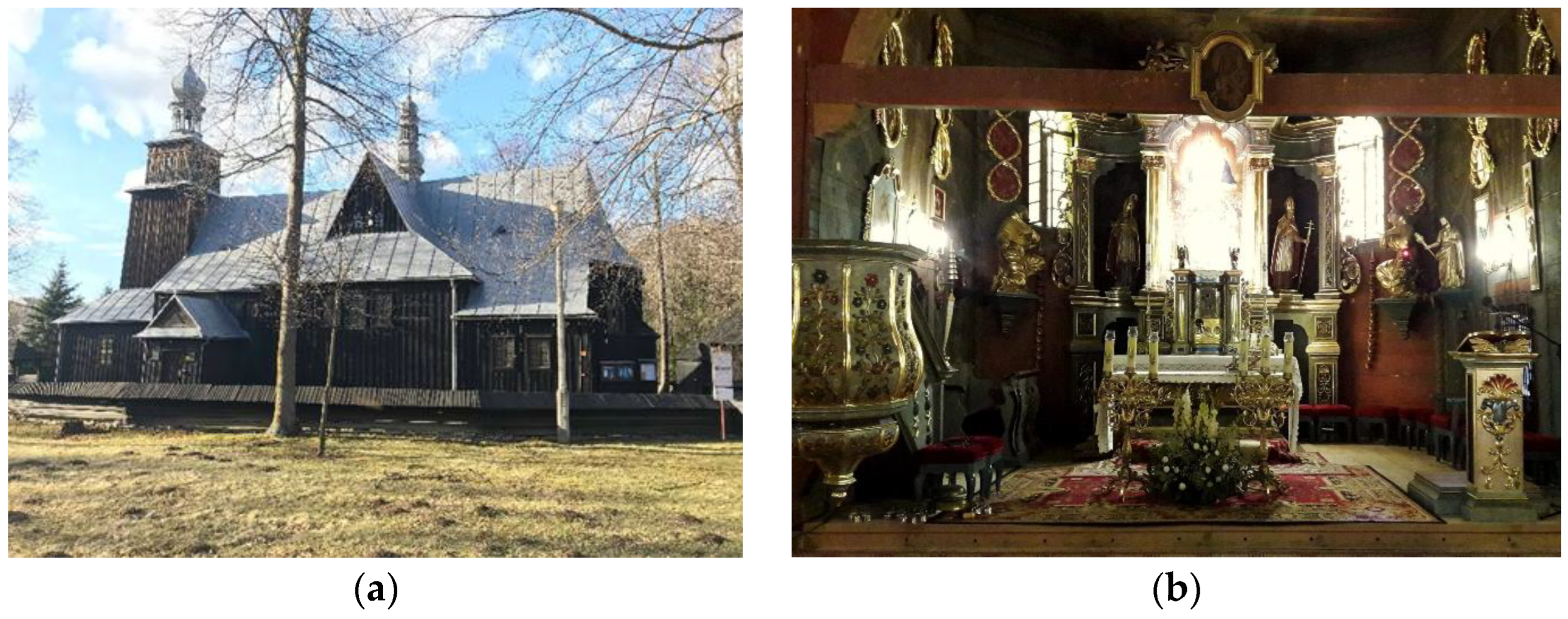
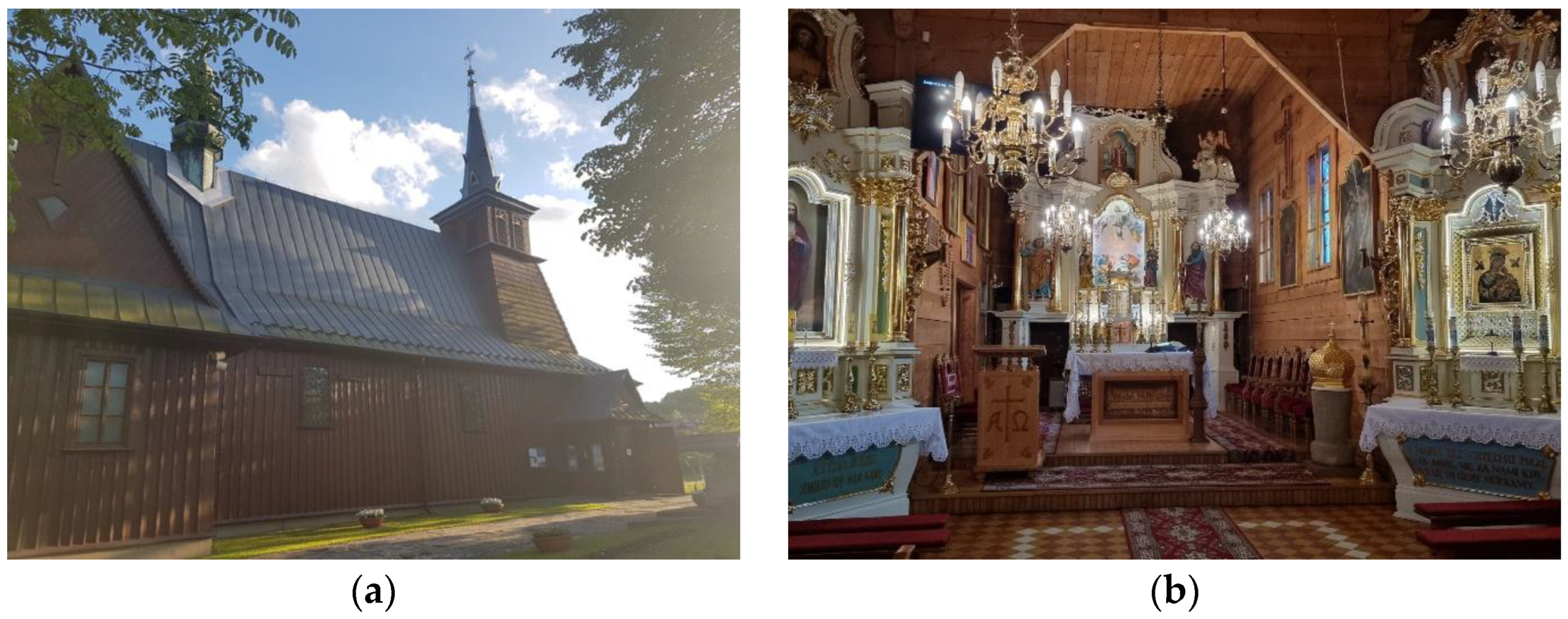




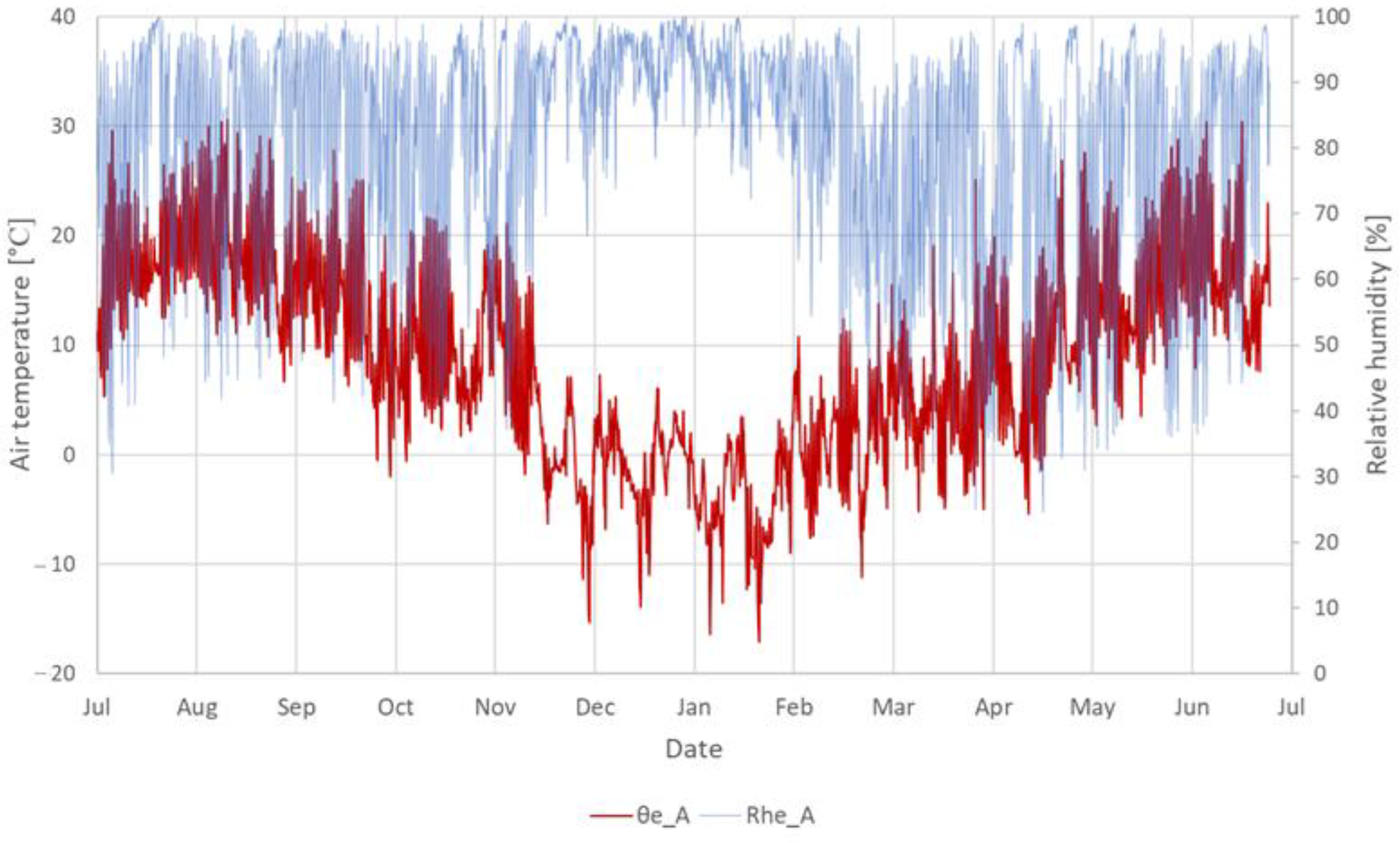




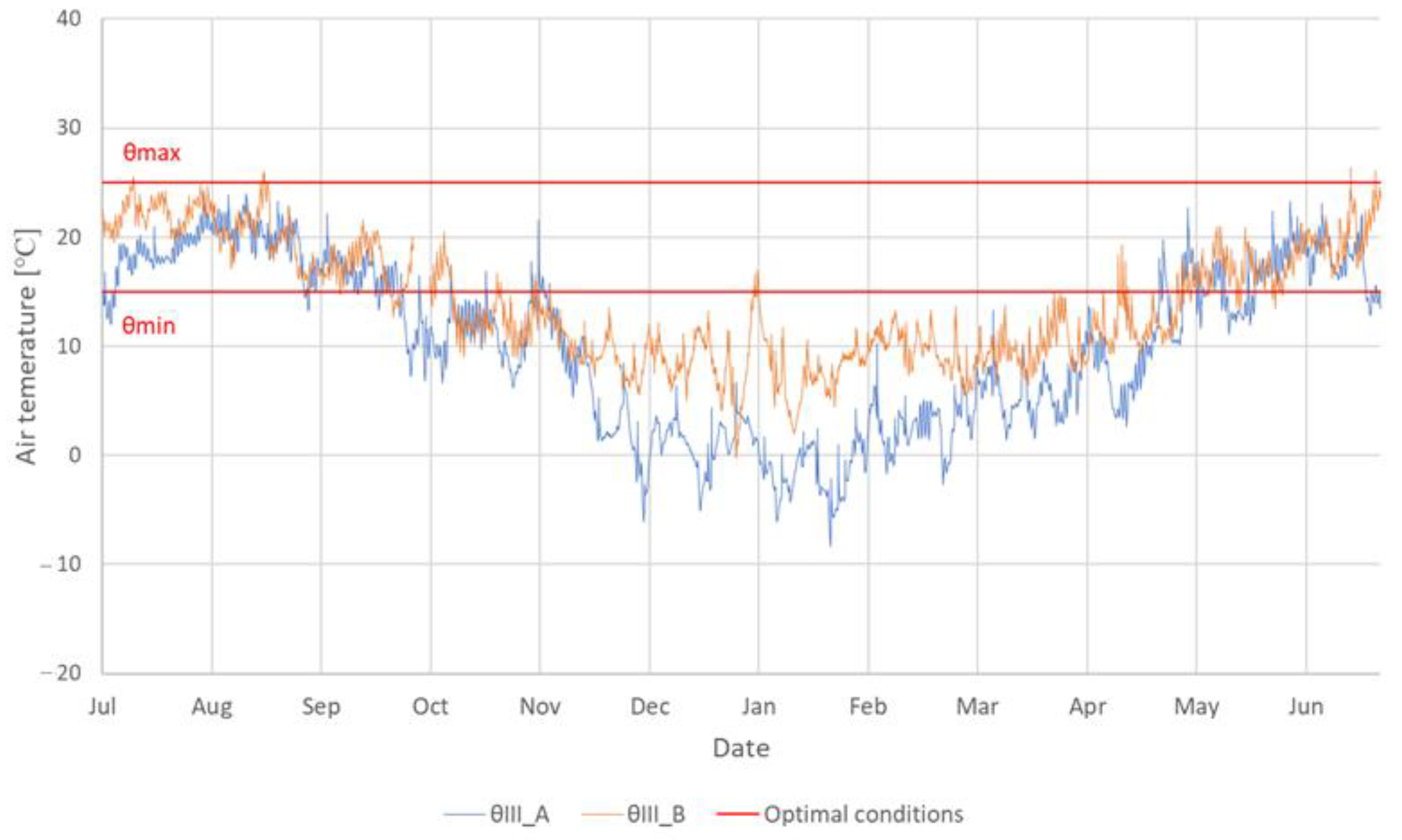

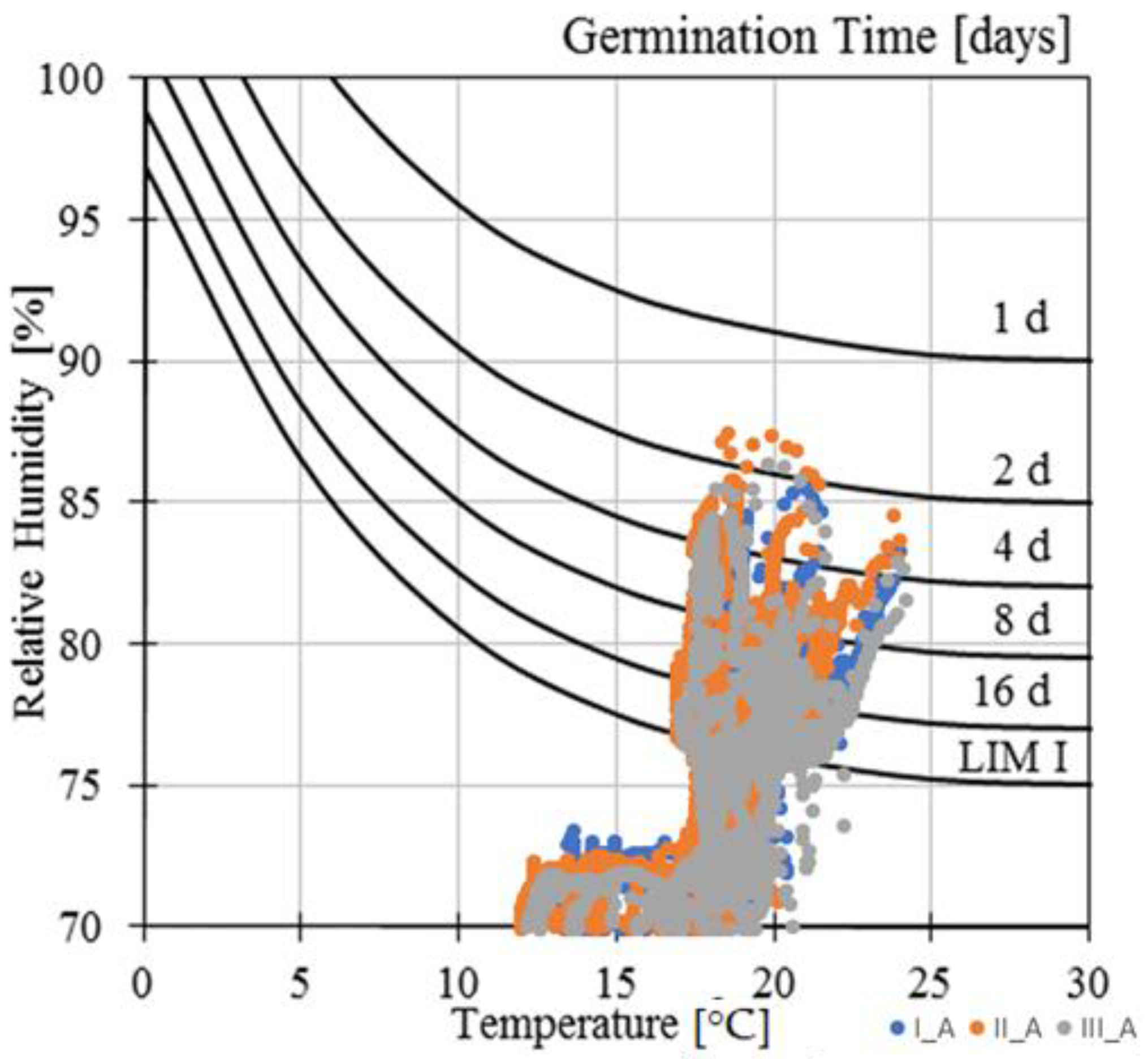
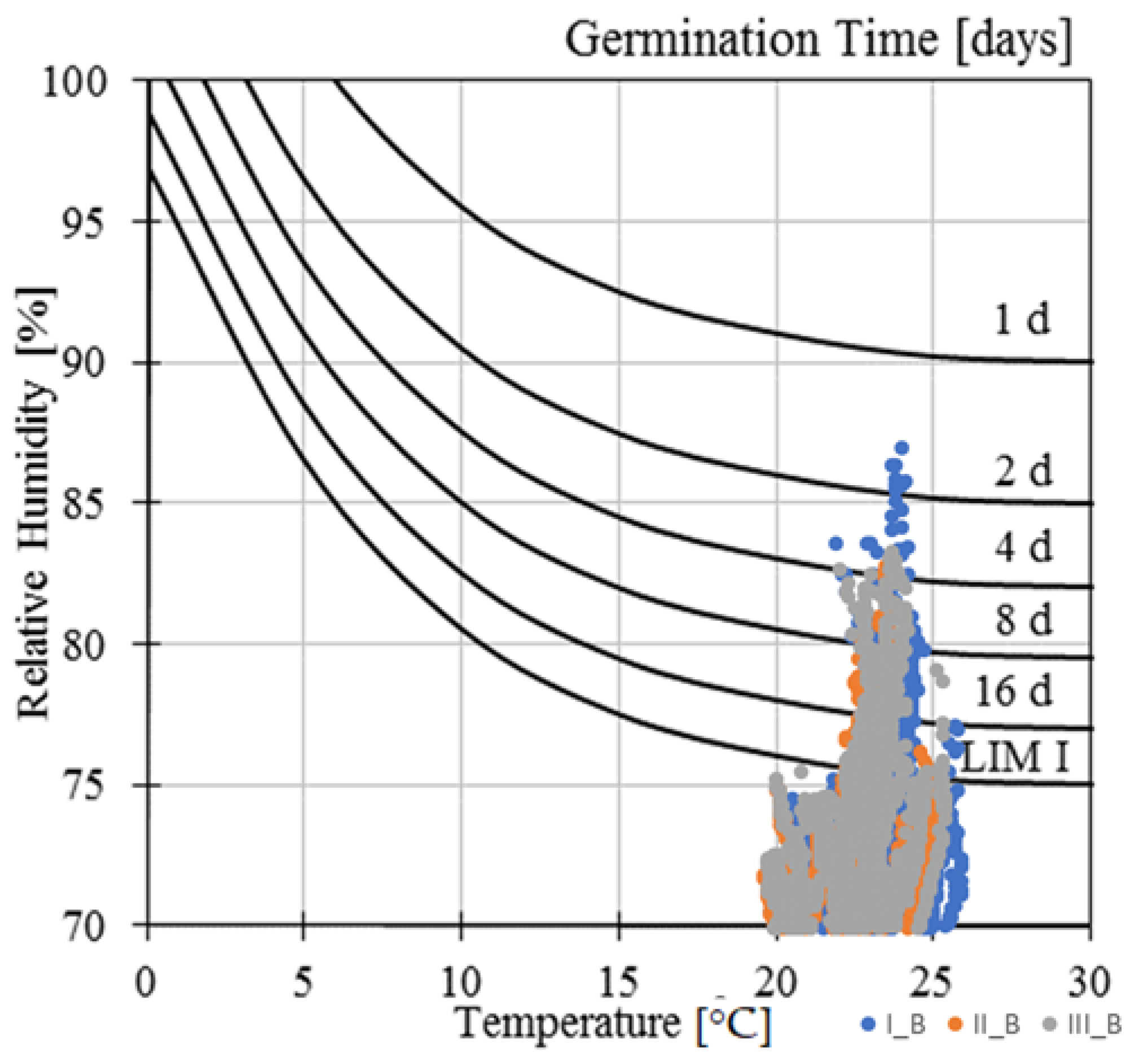

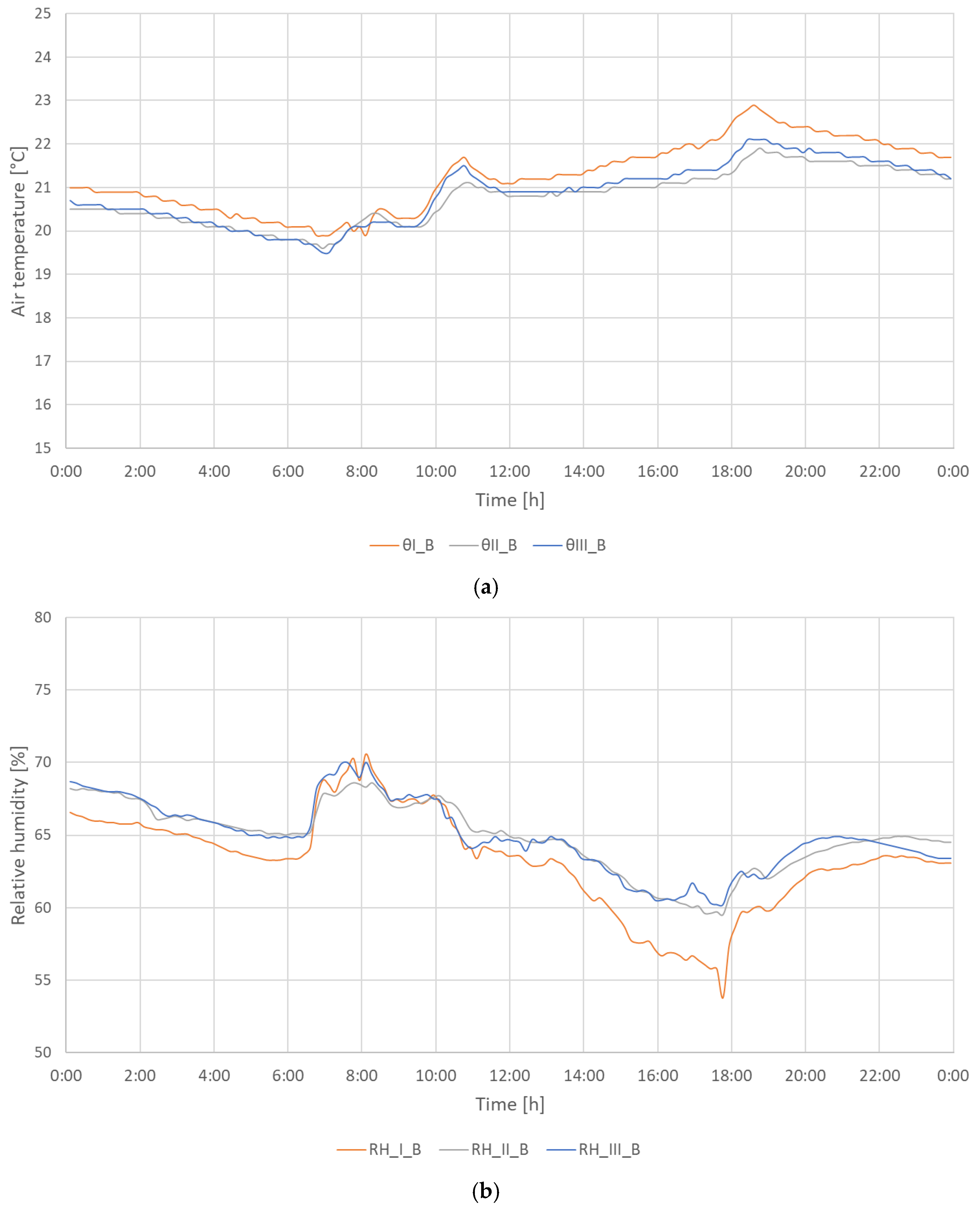
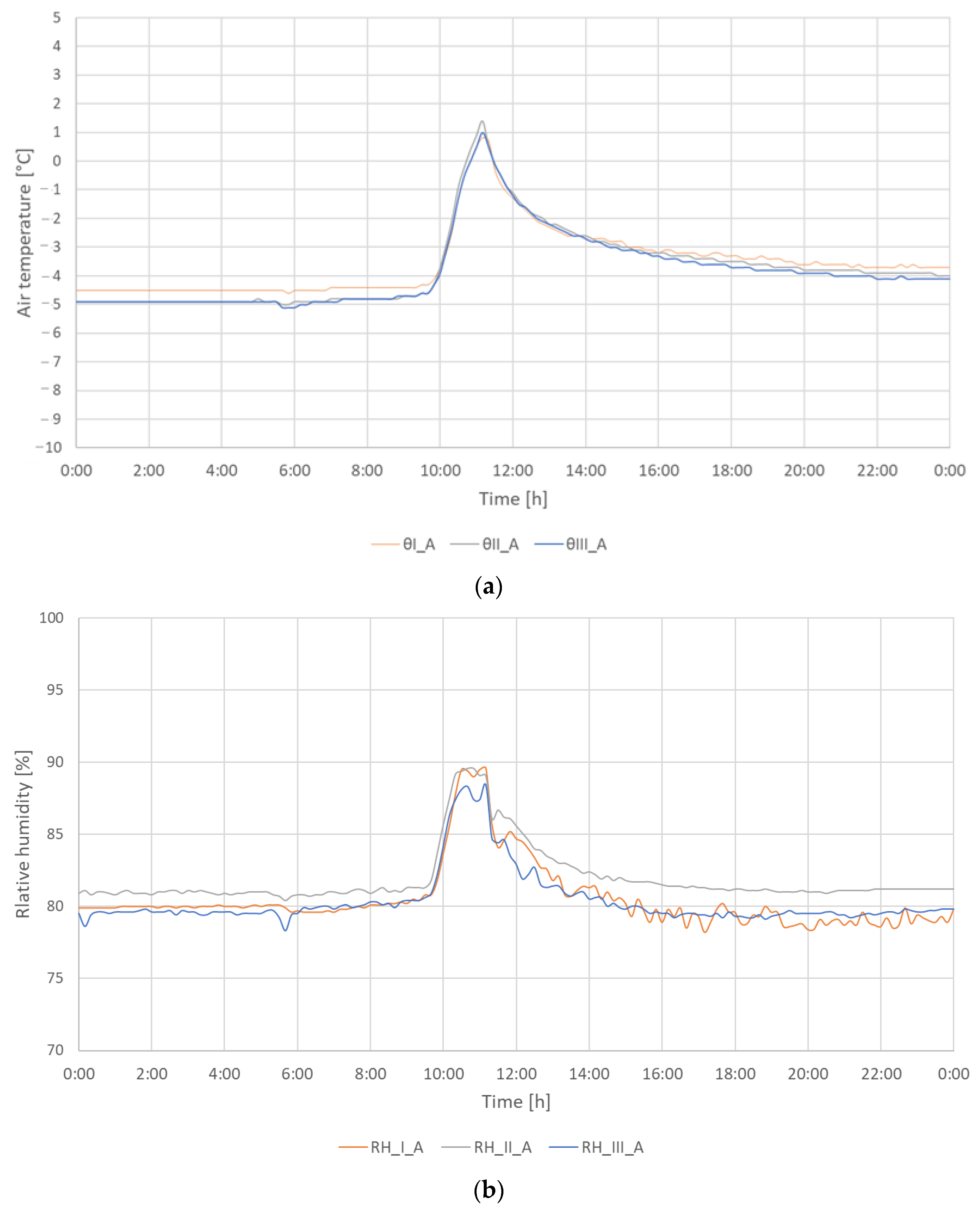
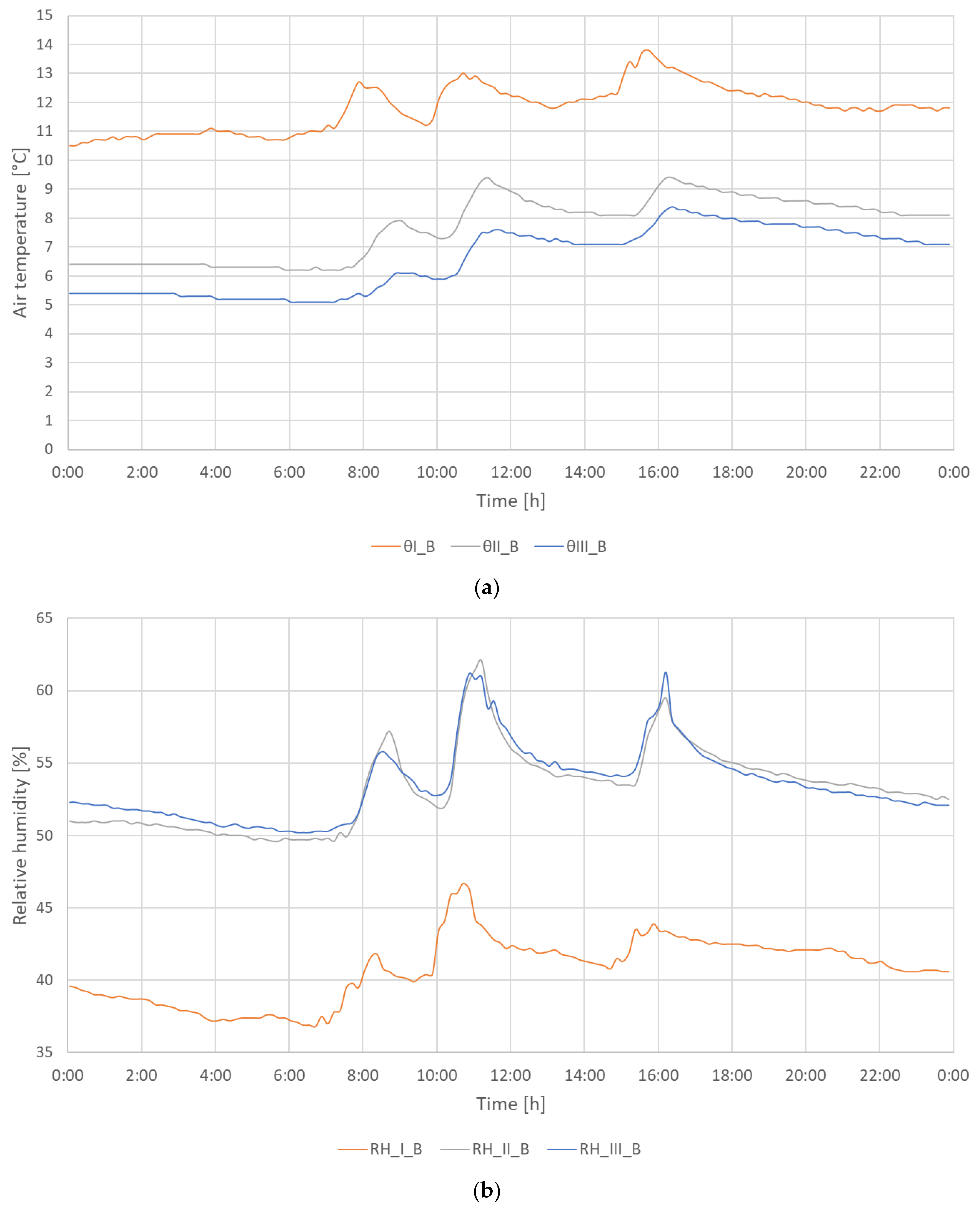
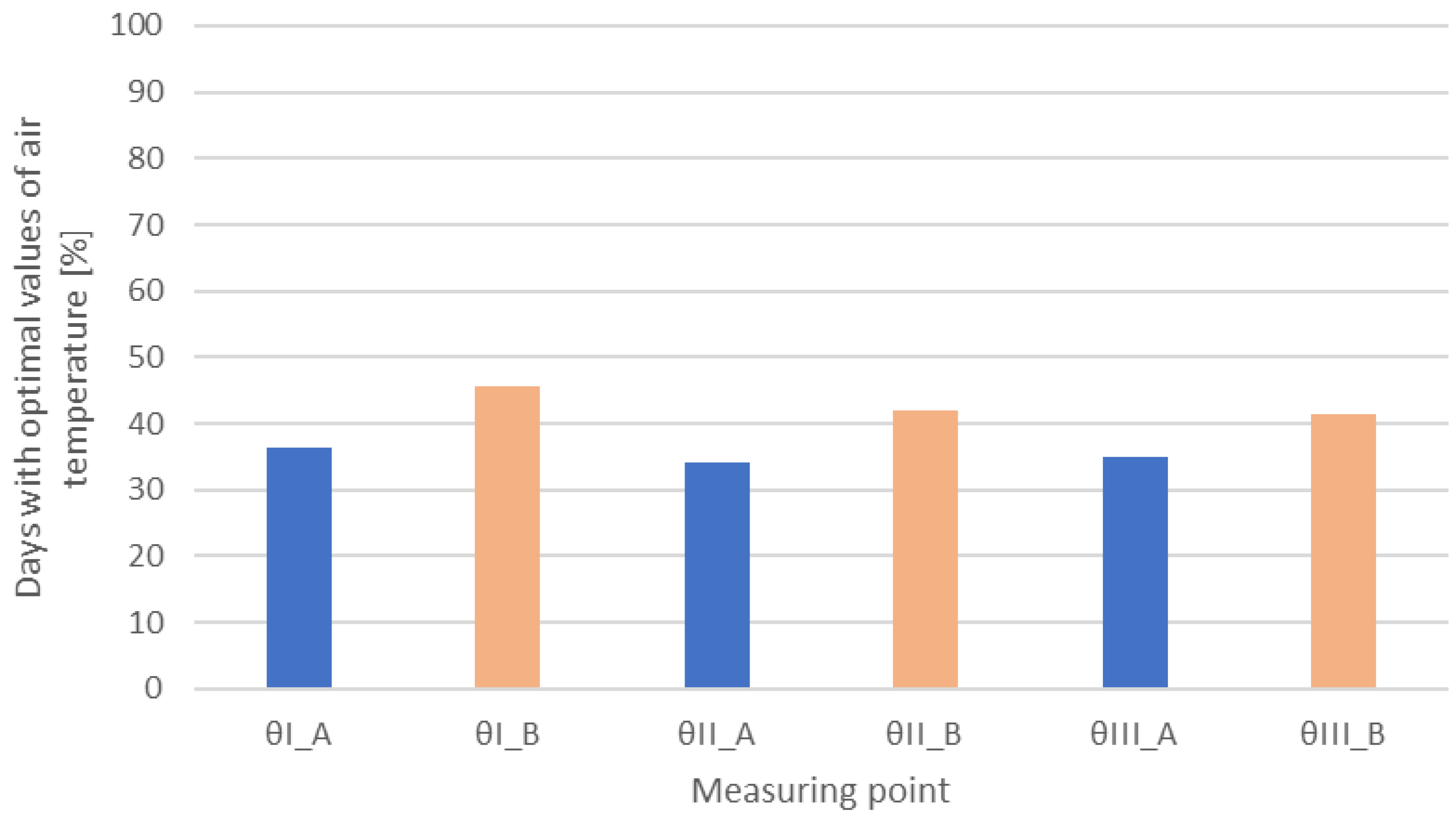



Disclaimer/Publisher’s Note: The statements, opinions and data contained in all publications are solely those of the individual author(s) and contributor(s) and not of MDPI and/or the editor(s). MDPI and/or the editor(s) disclaim responsibility for any injury to people or property resulting from any ideas, methods, instructions or products referred to in the content. |
© 2025 by the authors. Licensee MDPI, Basel, Switzerland. This article is an open access article distributed under the terms and conditions of the Creative Commons Attribution (CC BY) license (https://creativecommons.org/licenses/by/4.0/).
Share and Cite
Nawalany, G.; Michalik, M.; Sokołowski, P.; Michalik, E.; Lofek, Z. The Threat of Moisture in the Partitions of Unheated and Heated Wooden Historic Churches in Poland. Sustainability 2025, 17, 2941. https://doi.org/10.3390/su17072941
Nawalany G, Michalik M, Sokołowski P, Michalik E, Lofek Z. The Threat of Moisture in the Partitions of Unheated and Heated Wooden Historic Churches in Poland. Sustainability. 2025; 17(7):2941. https://doi.org/10.3390/su17072941
Chicago/Turabian StyleNawalany, Grzegorz, Małgorzata Michalik, Paweł Sokołowski, Elżbieta Michalik, and Zbigniew Lofek. 2025. "The Threat of Moisture in the Partitions of Unheated and Heated Wooden Historic Churches in Poland" Sustainability 17, no. 7: 2941. https://doi.org/10.3390/su17072941
APA StyleNawalany, G., Michalik, M., Sokołowski, P., Michalik, E., & Lofek, Z. (2025). The Threat of Moisture in the Partitions of Unheated and Heated Wooden Historic Churches in Poland. Sustainability, 17(7), 2941. https://doi.org/10.3390/su17072941




